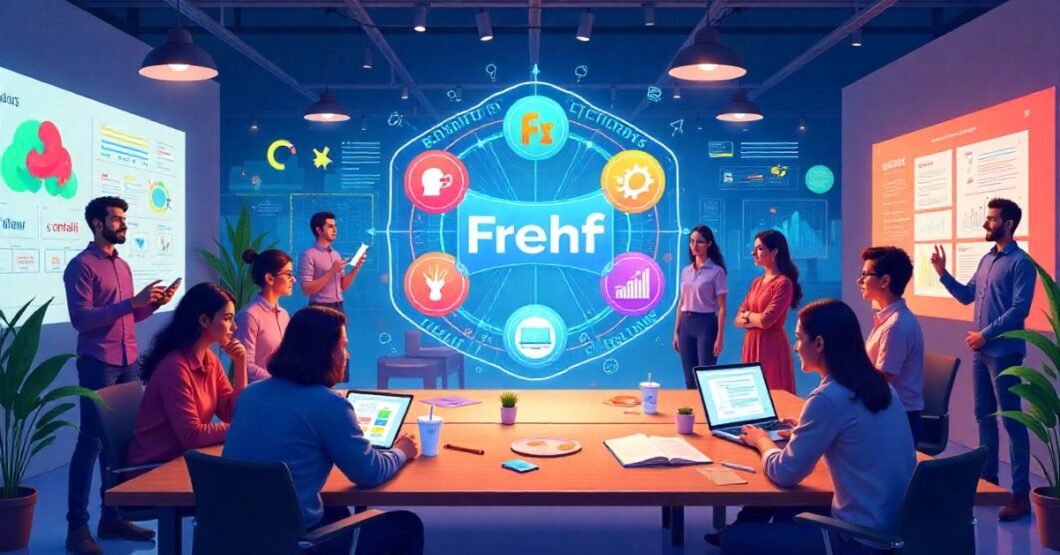Introduction
The capacity to change, innovate boldly, and adapt quickly has become a competitive tool in the current business environment, which is highly dynamic, with disruption of the new reality and agility the new requirement. That’s where Frehf comes in.
“Frehf” is not a buzzword; it is a philosophy and framework that believes in flexibility, resilience, execution, hybrid thinking, and forward motion. The attitude and paradigm are what drive flexible innovation in the contemporary industries, from the technological industry and healthcare to manufacturing and marketing.
With the future of our society being shaped by artificial intelligence, volatility in the market, remote working, and societal transformation, those industries that adopt Frehf are bound to be more prosperous. Businesses, executives, and groups who use its fundamental tenets are in a better position to innovate at a higher rate, think smarter, and be quicker in a complex world.
This guide will teach you all that you need to know about it, its origin, its structure, its benefits, its case studies, and how to apply the same to your organization. This article will provide you with the instruments to become a purpose-led, confident innovator and resilient adaptor regardless of whether you are a startup leader, enterprise strategist, or forward-thinking learner.
What is Frehf? Understanding the Concept and Its Core Pillars
“Frehf” can be translated to mean:
- F—Flexibility: Dynamic strategy change.
- R—Resilience: Recovering after a failure.
- E – Execution: Converting ideas to actuals.
- H – Hybrid Thinking: Embracing logic, emotion, and creativity.
- F—Forward Motion: Constantly advancing and developing.
Key Aspects of Frehf:
- Combines innovativeness, realism, and emotional intelligence.
- Easy to work in uncertainty and complexity.
- People-oriented and system-wise.
- Lays stress on learning agility and flexibility of mindset.
- Promotes forward and progressive failure and innovation.
With the incorporation of it, businesses and individuals are not just engaged in the traditional models of innovation but in active change.
The Role of Frehf in Modern Business Innovation
Old paradigms of innovation are linear and conservative, whereas the modern requirements are hectic and fast. The non-linear dynamics of prototype, disrupt, and reframe are provided by it, fast.
Frehm contributes to innovative activity:
- Promotes ideation elasticity—the development of ideas on the fly.
- Constant solution adaptation.
- Likes experimentation to perfection.
- Cultures fail fast and learn faster.
Real-World Applications:
| Company | Frehf in Action |
| Netflix | Pivoting from DVD rentals to global streaming (forward motion) |
| Spotify | Continuous micro-testing via squads (execution + flexibility) |
| Etsy | Blending artistic creativity with big data (hybrid thinking) |
It makes sure that innovation is strategic, scalable, and long-lasting rather than merely reactive.
Key Benefits of Applying Frehf in the Workplace
Organizations benefit from the Frehf model in every vertical, including customer experience, performance, and culture.
Principal Advantages:
- Promotes cooperation across functional boundaries
- Lessens opposition to change
- Encourages employee independence and innovative risk-taking
- Creates a workforce that is resilient and learning-driven
- Increases the speed at which ideas and products reach the market.
Quantifiable Data:
| Metric | Pre-Frehf Organizations | Frehf-Adopting Organizations |
| Idea to Execution Time | 6-9 months | 2-4 months |
| Employee Innovation Engagement | 40% | 75%+ |
| Recovery Time After Setbacks | Slow and siloed | Fast and cross-departmental |
It offers quantifiable commercial value and is more than just a mindset.
Frehf vs. Traditional Innovation Models (Comparative Table)
Are you curious about how Frehf compares to antiquated innovation systems?
Comparative Analysis:
| Element | Traditional Innovation | Frehf Model |
| Structure | Top-down | Distributed & dynamic |
| Speed | Planned cycles | Real-time feedback loops |
| Creativity Approach | Formal R&D labs | Everyone innovates |
| Failure Management | Avoid at all costs | Encourage intelligent risk |
| Team Collaboration | Departmental silos | Cross-functional squads |
| Change Adoption | Slow | Agile & iterative |
Every worker at it becomes an inventor, and every obstacle is turned into a chance.
The Psychology Behind Frehf: Mindset and Motivation
It flourishes under the presence of psychological security and developmental attitudes.
Cognitive Roots of Frehf:
- Students are open to experimentation.
- The leaders are the ones who exemplify resilience by being open.
- There is responsibility and recognition in teams.
- Errors are not the ends, but the means.
Motivation Drivers:
- Purpose-driven work
- Autonomy and trust
- Diverse thinking spaces
- Culture of constructive feedback.
This can render Frehf particularly applicable to Gen Z and Millennial employees, who desire meaning, flexibility, and teamwork, as opposed to ranks.
Case Studies: Real Organizations Applying Frehf Successfully
Let’s see how actual businesses use of it values to spur innovation and expansion.
Case Study 1: Airbnb (Post-Covid Recovery)
Challenge: During the COVID lockdown, the entire operation was interrupted.
Frehf’s action:
- shifted the platform’s emphasis to “Experiences” online
- Decentralized creativity with international volunteer groups
- encouraged staff members to propose features during “Hack Weeks.”
Result: 35% faster than expected user growth was restored.
Case Study 2: Adobe (In-House Creativity Kits)
Action: “Kickbox” was created, a collection of tools inspired by it that enables any staff member to propose and carry out innovative ideas across departments.
Result
- Almost 1,000 ideas were created.
- More than 25 were turned into new Adobe products.
In conclusion, it promotes originality from the ground up, bolstered by organized adaptability.
How to Build a Culture of Frehf in Your Team or Organization
Actionable Steps:
- Launch innovation education and failure storytelling.
- Foster multi-functional teamwork.
- Develop systemic freedom—specific objectives but loose means.
- Be creative in adopting OKRs (Objectives and Key Results).
Culture Signals:
- What would we learn from this?
- Test and tweak
- No hybrid job definitions No strict job definitions
Good companies do not adhere to it; they get it-oriented cultures.
Tools, Frameworks, and Technologies That Support Frehf
An environment that is driven by it is made possible in large part by technology.
Toolkit Examples:
| Purpose | Tools |
| Brainstorming | Miro, FigJam |
| Agile Planning | Asana, Jira |
| Cross-collaboration | Notion, Slack, Confluence |
| Rapid Prototyping | Figma, Adobe XD |
| Employee-led Innovation Platforms | Brightidea, IdeaScale |
The openness, fluidity, and real-time sharing that are essential to the it attitude are made possible by technology.
Common Pitfalls & How to Avoid Them When Adopting Frehf
It is possible for even brilliant ideas to be misinterpreted or diluted. On your it journey, steer clear of these pitfalls:
Pitfall 1: Only leaders drive execution.
Fix: Encourage experimentation from the bottom up.
Pitfall 2: Treating Frehf like a one-time campaign
Fix: Include it in performance frameworks and OKRs.
Pitfall 3: Confusing chaos with flexibility
Fix: Combine flexibility with deadlines and accountability.
Pitfall 4: No feedback loop
Fix: Retrospectives can be used to iteratively improve the process.
The process of creating a it culture is dynamic, much like invention.
The Future of Frehf: Evolving Innovation in 2025 and Beyond
Emerging Trends Supporting the Rise of Frehf:
- Workplace cultures that prioritize remote work and embrace asynchronous innovation
- Ideation aided by AI—Frehf plus AI equals exponential inventiveness.
- Static roles are being replaced with flexible job definitions.
- Situational needs-based theories of adaptive leadership
Organizations that adopt the it attitude are able to adapt quickly to change, not only surviving disruption but even designing through it.
FAQs
Is Frehf a methodology or a way of thinking?
It is both a strategic mindset movement, which employs flexible approaches to remain innovative and future-oriented.
Is Frehf helpful to small businesses?
Absolutely. As a matter of fact, startups naturally work with its principles, but they only need to make conscious choices to scale them.
What is the difference between Frehf and Agile?
Agile is primarily a project management system; it is holistic, directing attitude, design thinking, activities, and culture.
Does Frehf apply to other sectors?
Yes. Adaptability is beneficial in healthcare, education, sustainability, finance, and any other sector where the change happens very fast.
How do we track Frehf’s success?
Evaluate the levels of innovation engagement, idea-to-market speed, resiliency in the aftermath of faults, and adaptability factors among groups.
Conclusion
Business is changing at a speed too quick for the processes that used to be and too complex for the hierarchies of old. The adaptable, flexible, and creative mindset of Frehf provides an innovative blueprint on how to develop the industry amidst the uncertain times.
Your organization will not only be able to keep up with change by integrating its main values, which consist of flexibility, resilience, execution, hybrid thinking, and forward motion. It will lead to it.
It is high time to no longer plan on being innovative and instead build a firm where innovation is in the DNA. Allow the Frehf mind to find your way to a worthy, contemporary development.




